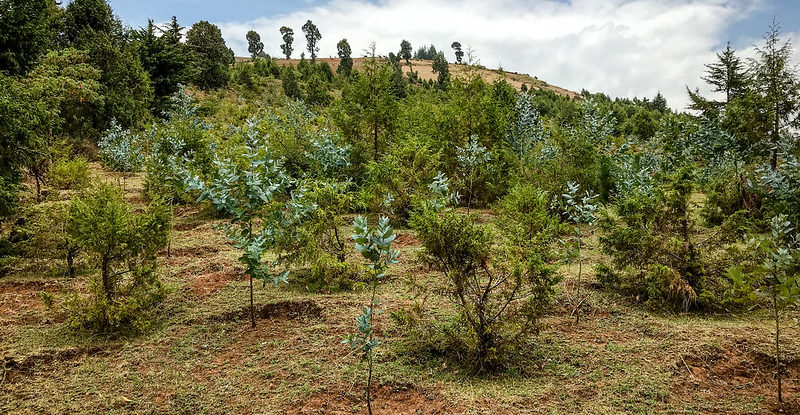
Tree planting in Ethiopia presents opportunities, but also poses unique challenges for local communities. Limited opportunities to influence decisions about reforestation and difficulties securing long term rights to and benefits from trees hinder efforts. Yet with support, the country will be able to meet its tree planting targets, researchers say.
Ethiopia has committed to rehabilitate 15 million hectares under the African Forest Landscape Restoration Initiative (AFR100), which is 15 percent of the continental target of reforesting almost 100 million hectares by 2030.
For Ethiopia to effectively meet its goals, it needs to address issues of land tenure, and implement socially inclusive, participatory planning and objective setting, and performance-based monitoring, according to an article published in a special issue of the journal of Forest Ecology and Management.
Reforestation policies should take into consideration the lack of historical land-use data, which heightens the risk that an area targeted for reforestation may not have previously been forested, increasing the potential for negative environmental consequences if afforestation is implemented.
“Current tree-planting targets are based on the belief that forests covered 40 percent of the country’s land area and that they were depleted throughout the 20th century, but we don’t know that for a fact,” said Habtemariam Kassa, a principal scientist with the Center for International Forestry (CIFOR) Research and World Agroforestry (ICRAF) and one of the authors of the paper, explaining that the earliest national survey of forest cover in 2000 indicated that only 12 percent of the country was forested or covered in woodland. “We don’t have national-level data before that.”
“The challenge is that afforestation on areas that have not supported forests in the past, such as grassland, pastoral areas or drylands, can have a negative impact on water yields, reduce carbon sequestration potential and result in more volatile fires,” added co-author Plinio Sist, a scientist with France’s Agricultural Research Center for International Development (CIRAD).
About half of land in Ethiopia is used for pastoral and agropastoral activities and scientists are concerned that afforestation, wrongly identified as reforestation, could impinge on these areas. Currently, these areas are under threat from exotic and indigenous invasive woody species, which could be misidentified as natural regeneration.
Further complicating matters, the scientists learned that there is also a perception that local communities in Ethiopia cause forest loss because they are poor and as a result, out of need, put undue pressure on resources.
Yet the relationship between poverty and deforestation is not that simple, said Stibniati Atmadja, a scientist at CIFOR-ICRAF, and a co-author on the paper. “The rich and powerful have more means to do more harm to forests.”
In some areas, although regreening is occurring, vegetation can be invasive and harmful to local livelihoods reliant on native species. For example, the shrub Prosopsis juliflora, known as mesquite in North America, is spreading rapidly in former grazing lands, causing economic hardship and conflict in pastoral communities. These pastoralists are often excluded from decision-making processes but should be involved in making decisions regarding how to manage trees and if and where to plant trees and for what purpose, Kassa said.
Through a literature review and decades of field experience, the researchers identified the lack of national land use policy and planning, and unclear rights to trees planted on communal lands as two critical factors prohibiting effective reforestation, compounded by the inability to clearly show economic benefits for local communities from growing trees.
“Policies should place greater emphasis on increasing productivity and economic returns for communities managing lands undergoing tree planting or assisted natural regeneration efforts,” said Manuel Guariguata, a principal scientist at CIFOR-ICRAF and a co-author on the paper.
Communities must be fully engaged in decision making regarding tree planting through involvement in selecting sites, deciding on objectives of tree planting and how to achieve them, and net benefit sharing arrangements in ways that also ensure social inclusion.
Over the next 20 years, the country’s wood product demand is projected to increase 27 percent. Already, Ethiopia is spending Birr 8 billion ($174 million) annually on importing wood products, and estimates indicate that 310,000 ha of trees on plantations will be required to keep up with industrial demand.
But the current situation will make that difficult, according to the researchers. A law exists requiring that timber extraction from natural forests must be based on an approved forest management plan, but very few forests in Ethiopia have one unless they have a participatory management scheme, which only covers non-timber forest products. These restrictions make it difficult for local communities to gain economic benefits from timber from natural forests, which means that legal timber comes from plantations.
“Gathering evidence and reflecting on the potential role local communities could play as active participants in reforestation to understand why some efforts fail, could go a long way toward improving the potential for success,” said lead author Manuel Boissière, a scientist with CIRAD and a CIFOR-ICRAF associate scientist.
Other recommendations include proper identification of lands for tree planting, putting social and environmental safeguards in place to protect against the risk of afforestation, increasing the use of technology to better monitor treed areas, and establishing better access for local communities with economic opportunities and markets for forest products.
We want you to share Forests News content, which is licensed under Creative Commons Attribution-NonCommercial-ShareAlike 4.0 International (CC BY-NC-SA 4.0). This means you are free to redistribute our material for non-commercial purposes. All we ask is that you give Forests News appropriate credit and link to the original Forests News content, indicate if changes were made, and distribute your contributions under the same Creative Commons license. You must notify Forests News if you repost, reprint or reuse our materials by contacting forestsnews@cifor-icraf.org.